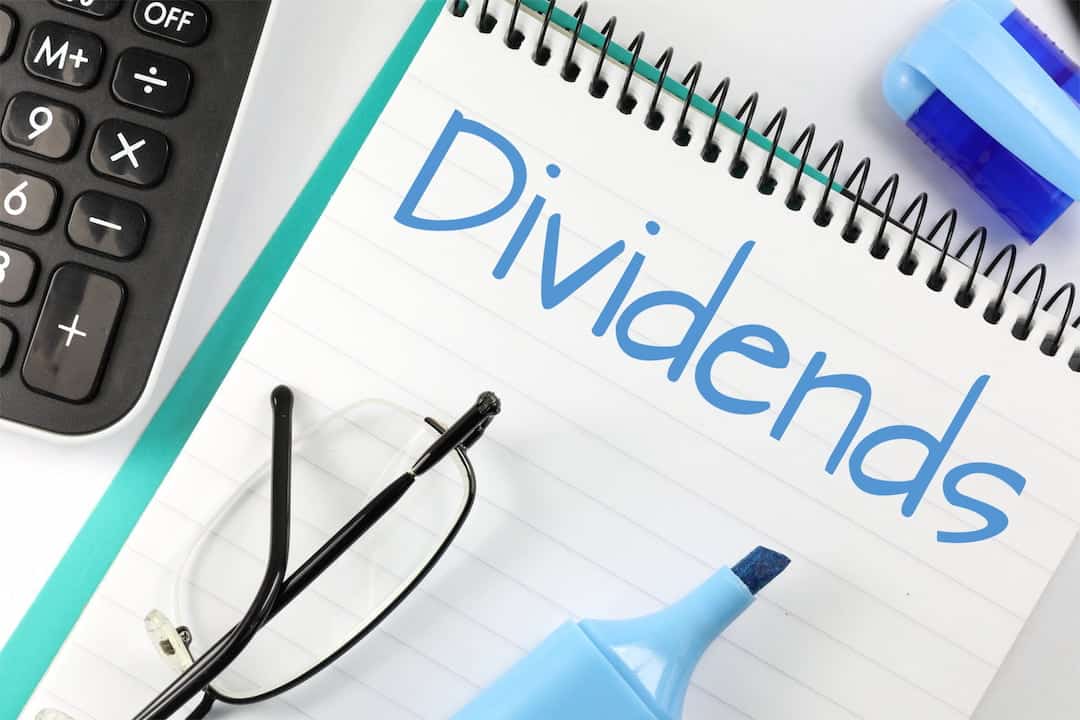Dividends are all too familiar if you own stocks in a Canadian company. Depending on the stock options and how often the company issues them, they can affect your annual income.
The Canadian Dividend Tax Credit can be challenging to navigate. However, it depends on an individual’s financial situation and long-term goals. For sound tax planning and to cut tax payable, it’s critical to claim the correct tax credit and report dividends from suitable sources.
Find out if you qualify for the Dividend Tax Credit Canada and how to apply for it.
What is Dividend Tax Credit Canada?
Through the distribution of the company’s profits, its shareholders get paid (see ‘Best Canadian Stocks to Hold Forever‘). Shareholders get a dividend for any surplus or profit that a Canadian corporation makes.
The Canadian Revenue Agency (CRA) requires you to report dividends on your tax return each year. So you can claim the Dividend Tax Credit. Individuals receive this non-refundable tax break to help them avoid double taxation on the same income.
After-tax earnings often pay dividends, so the companies that pay shareholders have already filed tax returns for them. As a result, taxing the recipient on the same amount is illogical. To ease the risk of double taxes on dividends, the CRA introduced the Dividend Tax Credit.
Remember that the DTC only applies to individuals and not businesses. Your company can’t benefit from the DTC if it receives dividends from another Canadian company (see ‘Blue Chip Stocks Canada‘).

How Much Tax Do You Pay on Dividends in Canada?
When calculating taxable income, a Canadian corporation can deduct dividends received from another Canadian corporation in full. Dividends on certain preferred shares received by a “specified financial institution” are an important exception and the tax is a full corporate rate.
They can tax a corporate recipient of dividends at a rate of 10% unless the payer pays a 40% tax on the dividends paid. CRA can deduct tax from the taxpayer’s taxable income. The tax doesn’t go into effect if preferred-share dividends total less than CAD 500,000 in the year. A shareholder with “substantial interest” in the payer is exempt from this rule.
A special refundable tax of 38% is on dividends received by private or public corporations controlled by one or more individuals from Canadian corporations (see ‘Best Canadian Stocks to Buy Right Now‘. In order to tax the recipient of dividends, the payer must first receive a tax refund. Refundable dividend tax is 38% of taxable dividends paid by the recipient.
Dividends on Stocks
If the recipient is a Canadian resident, stock dividends tax – see stock gains tax, too – is similar to cash dividends. The payer corporation’s paid-up capital must increase to calculate the taxable portion of a stock dividend. Non-resident stock dividends are not subject to this rule. Instead, the value of the shares received is zero.
On a separate note, we already covered topics such as ‘Stock Market Investing for Beginners‘ as a way to secure your financial future. As stocks are not the topic of this post, we’ll mention several other articles that are deal with things related to stocks in more depth. For example, strategies for new investors and two popular platforms are reviewed in ‘Day Trading for Beginners‘ and ‘Day Trading for Canadians‘ posts. Lastly, how to profit from changing trends is explained in ‘Swing Trading Strategies‘ post.
Eligible Dividend vs Non-Eligible Dividend Tax Credit
The following are the three types of dividends you can receive:
- Eligible dividend
- Non-eligible dividend
- Foreign dividend
In Canada, it is possible to claim the Dividend Tax Credit for dividends that are both eligible and non-eligible.
Tax Credit for Enhanced Dividends and Eligible Dividends
Public corporations determine which dividends are eligible. Most dividends received from equities investments are eligible dividends. The tax credit is only available for eligible dividends.
Corporations that designate dividends as “eligible” get a higher tax rate than those that do not. To balance the rising dividend tax and credit, personal dividends rise because of the “gross-up” effect of federal and provincial tax rates. Ultimately, higher rates and tax credits offset a person’s lower tax burden.
Non-Eligible Dividends
Small business tax rates – check out also ‘Penny Stock Canada‘ – do not apply to dividends received from Canadian-controlled private corporations (CCPCs). Because the tax rate for CCPCs is lower than that for non-CCPCs, corporations pay less in taxes on non-eligible dividends.
The EDTC does not apply to non-eligible dividends because they tax them lower. A lesser dividend tax credit rate means that they pay less in taxes.
Foreign Dividends
The Dividend Tax Credit in Canada doesn’t apply to dividends coming from foreign sources. Dividends from overseas companies are subject to tax at a higher rate for Canadian investors (see also ‘Best Online Brokerage‘).

What is Dividends Gross-Up?
To determine your taxable income for the year, you must include dividend income. You should consider the “gross-up” when reporting dividend income. For tax, the gross-up is an increase in the dividends.
CRA reclassifies dividends as post-tax income if you pay a gross-up on them, and the Dividend Tax Credit offsets this gross-up. There is no need for you to pay tax on the dividends you get from the corporation.
The CRA reimburses you, the dividend recipient, for the corporate income tax on your dividends. In a nutshell, this ensures that the corporation, the payee, and the Canada Revenue Agency (CRA) are all treated fairly.
What Is the Effect of Dividend Gross-up on Dividend Tax Rates
The dividend gross–up and related dividend tax credit account for the portion of the tax that a company (see Canada Nickel stock) has paid on a revenue stream before the dividend issue. Canada’s basic corporate tax rate is 38%, but federal tax discounts of 10% reduce it to 15%.
The small business deduction (see also ‘Small-Cap Stocks Canada‘) is only available to Canadian-owned private corporations that are subject to Canadian taxation (CCPCs) must have active commercial income, bringing down the federal corporate tax rate to 10% as of 2018.
Because each province sets its corporate tax rate, the federal tax reduction applies only to corporations that pay provincial taxes. In Ontario, a CCPC’s tax rate is 13.5 percent, while the non-CCPC tax rate is 26.5 percent in Ontario’s combined federal and provincial tax rate.
They divide dividends as either eligible or non-eligible in order to balance out the mismatch in corporate tax payments. It is important to note that dividends issued by non-CCPCs and CCPCs have lower taxes than CCPC dividends.
To accomplish this, dividends that are eligible and non-eligible are subject to different dividend rates and DTC rates. The goal of dividend gross-up is to approximate the amount of income required to issue a particular dividend.

How To Calculate the Dividend Tax Credit
There are a lot of numbers and percentages to remember when calculating the Dividend Tax Credit. Calculating gross-ups, calculating the federal and provincial dividend tax credits, and analyzing all of this information can be confusing (see ‘Fundamental vs Technical Analysis‘).
However, the person receiving the dividend is subject to a provincial and federal dividend tax credit. It is to account for the tax that the company issuing the dividend paid.
Following the calculation of an individual’s last tax bill for the year, the federal dividend tax credit of 15% and the provincial DTC of 10% of the gross-up dividend would eliminate that amount of tax owed.
How To Calculate the Federal Dividend Tax Credit
With the FDTC, you can pay less tax on your dividends. Taxpayers can take advantage of a credit to offset the higher dividend tax rate put in place by the Canadian Revenue Agency (CRA).
It lowers the tax bracket on dividends to that of salary, interest, and overseas dividends. The FDTC rate varies depending on whether a dividend is eligible. With dividends paid abroad, this rule does not apply.

How To Calculate Provincial Dividend Tax Credits
Canadians can take advantage of a federal dividend tax credit and a provincial dividend tax credit. Adding the provincial dividend tax credits to the FDTC can help lower an individual’s tax burden even further.
Province-to-province variations in the DTC rates apply to eligible and non-eligible dividends. For example, suppose John lives in Ontario. In that case, he is subject to a 10% Ontario Dividend Tax Credit on eligible dividends and 2 percent on non-eligible dividends to reduce his tax burden further.
How to Get the Dividend Tax Credit
To receive the Dividend Tax Credit, you must disclose dividends on your tax return. The Canada Revenue Agency (CRA) has designated tax forms for the declaration of investment and dividend income. It would be best to use it to calculate dividends and tax breaks for you.
You must show whether your dividends are eligible, non-eligible, or foreign to your tax return. Taxpayers can claim the Dividend Tax Credits on Schedule 1 of their federal income tax returns on Line 425. If all that sounds too difficult, you can check out some of the best robo advisors for guidance and help, but not until you research them properly.
The Bottom Line
Only Canadian residents who receive taxable dividends from Canadian resident companies qualify for the DTC. This is because the Canadian government considers it inappropriate to give you credit for the foreign corporate tax paid by the foreign corporation. Also, it doesn’t apply to dividends you receive from foreign companies. However, you will claim a foreign tax credit for the foreign taxes you pay on the dividends you receive from your company. A 15% withholding tax is common, but the rate varies depending on the country and the terms of Canada’s tax treaty with that country.